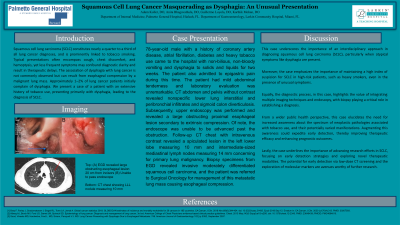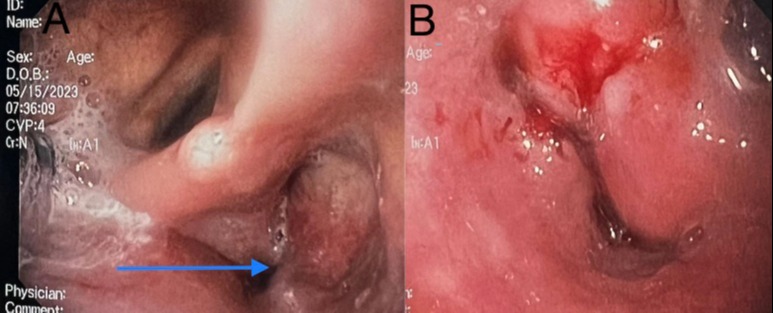Tuesday Poster Session
Category: Esophagus
P3303 - Squamous Cell Lung Cancer Masquerading as Dysphagia: An Unusual Presentation
Tuesday, October 24, 2023
10:30 AM - 4:00 PM PT
Location: Exhibit Hall

Has Audio

Adam Z. Koller, DO, MS
Palmetto General Hospital
Coral Gables, FL
Presenting Author(s)
Adam Z. Koller, DO, MS1, Anita Bhagavathula, DO2, Guillermo Loyola, BSc3, Karthik Mohan, DO4
1Palmetto General Hospital, Coral Gables, FL; 2LCH South Miami, Doral, FL; 3Nova Southern University, Miami, FL; 4Larkin Community Hospital, Miami, FL
Introduction: Squamous cell lung carcinoma (SCLC) constitutes nearly a quarter to a third of all lung cancer diagnoses, and is prominently linked to tobacco smoking. Typical presentations often encompass cough, chest discomfort, and hemoptysis, yet less frequent symptoms may confound diagnostic clarity and result in therapeutic delays. The association of dysphagia with lung cancer is not commonly observed but can result from esophageal compression by a malignant lung mass. Approximately 1–2% of lung cancer patients initially complain of dysphagia. We present a case of a patient with an extensive history of tobacco use, presenting primarily with dysphagia, leading to the diagnosis of SCLC.
Case Description/Methods: A 78-year-old male with a history of coronary artery disease, atrial fibrillation, diabetes and heavy tobacco use came to the hospital with non-bilious, non-bloody vomiting and dysphagia to solids and liquids for two weeks. The patient also admitted to epigastric pain during this time. The patient had mild abdominal tenderness and laboratory evaluation was unremarkable. CT abdomen and pelvis without contrast revealed nonspecific lower lung interstitial and peribronchial infiltrates and sigmoid colon diverticulosis. Subsequently, upper endoscopy was performed and revealed a large obstructing proximal esophageal lesion secondary to extrinsic compression. Of note, the endoscope was unable to be advanced past the obstruction. Follow-up CT chest with intravenous contrast revealed a spiculated lesion in the left lower lobe measuring 10 mm and intermediate-sized mediastinal lymph nodes measuring 14 mm concerning for primary lung malignancy. Biopsy specimens from EGD revealed invasive moderately differentiated squamous cell carcinoma, and the patient was referred to Surgical Oncology for management of this metastatic lung mass causing esophageal compression.
Discussion: This case illustrates an atypical manifestation of SCLC presenting as dysphagia due to esophageal compression by the lung mass. The patient's heavy tobacco use history aligned with known lung cancer risk factors, underscoring the need for maintaining a broad differential even when initial symptoms hint towards a gastrointestinal disorder. Diagnosis was achieved through judicious use of imaging modalities and endoscopy, with biopsy confirming SCLC. This case emphasizes the importance of maintaining high clinical suspicion for lung cancer in patients with significant risk factors, presenting with atypical symptoms like dysphagia.

Disclosures:
Adam Z. Koller, DO, MS1, Anita Bhagavathula, DO2, Guillermo Loyola, BSc3, Karthik Mohan, DO4. P3303 - Squamous Cell Lung Cancer Masquerading as Dysphagia: An Unusual Presentation, ACG 2023 Annual Scientific Meeting Abstracts. Vancouver, BC, Canada: American College of Gastroenterology.
1Palmetto General Hospital, Coral Gables, FL; 2LCH South Miami, Doral, FL; 3Nova Southern University, Miami, FL; 4Larkin Community Hospital, Miami, FL
Introduction: Squamous cell lung carcinoma (SCLC) constitutes nearly a quarter to a third of all lung cancer diagnoses, and is prominently linked to tobacco smoking. Typical presentations often encompass cough, chest discomfort, and hemoptysis, yet less frequent symptoms may confound diagnostic clarity and result in therapeutic delays. The association of dysphagia with lung cancer is not commonly observed but can result from esophageal compression by a malignant lung mass. Approximately 1–2% of lung cancer patients initially complain of dysphagia. We present a case of a patient with an extensive history of tobacco use, presenting primarily with dysphagia, leading to the diagnosis of SCLC.
Case Description/Methods: A 78-year-old male with a history of coronary artery disease, atrial fibrillation, diabetes and heavy tobacco use came to the hospital with non-bilious, non-bloody vomiting and dysphagia to solids and liquids for two weeks. The patient also admitted to epigastric pain during this time. The patient had mild abdominal tenderness and laboratory evaluation was unremarkable. CT abdomen and pelvis without contrast revealed nonspecific lower lung interstitial and peribronchial infiltrates and sigmoid colon diverticulosis. Subsequently, upper endoscopy was performed and revealed a large obstructing proximal esophageal lesion secondary to extrinsic compression. Of note, the endoscope was unable to be advanced past the obstruction. Follow-up CT chest with intravenous contrast revealed a spiculated lesion in the left lower lobe measuring 10 mm and intermediate-sized mediastinal lymph nodes measuring 14 mm concerning for primary lung malignancy. Biopsy specimens from EGD revealed invasive moderately differentiated squamous cell carcinoma, and the patient was referred to Surgical Oncology for management of this metastatic lung mass causing esophageal compression.
Discussion: This case illustrates an atypical manifestation of SCLC presenting as dysphagia due to esophageal compression by the lung mass. The patient's heavy tobacco use history aligned with known lung cancer risk factors, underscoring the need for maintaining a broad differential even when initial symptoms hint towards a gastrointestinal disorder. Diagnosis was achieved through judicious use of imaging modalities and endoscopy, with biopsy confirming SCLC. This case emphasizes the importance of maintaining high clinical suspicion for lung cancer in patients with significant risk factors, presenting with atypical symptoms like dysphagia.

Figure: (A) Blue arrow shows zoomed out view during upper endoscopy of proximal esophageal obstruction secondary to extrinsic compression (B) Zoomed in view during upper endoscopy of esophageal obstruction
Disclosures:
Adam Koller indicated no relevant financial relationships.
Anita Bhagavathula indicated no relevant financial relationships.
Guillermo Loyola indicated no relevant financial relationships.
Karthik Mohan indicated no relevant financial relationships.
Adam Z. Koller, DO, MS1, Anita Bhagavathula, DO2, Guillermo Loyola, BSc3, Karthik Mohan, DO4. P3303 - Squamous Cell Lung Cancer Masquerading as Dysphagia: An Unusual Presentation, ACG 2023 Annual Scientific Meeting Abstracts. Vancouver, BC, Canada: American College of Gastroenterology.
